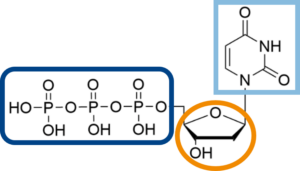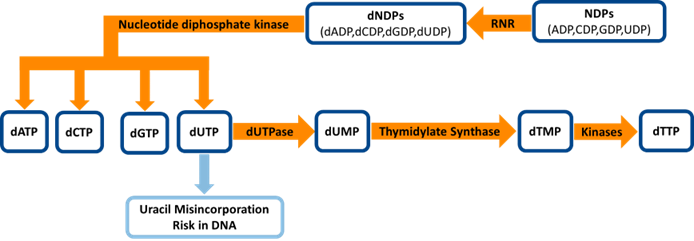The comprehensive guide to dUTP
What is dUTP?
dUTP (deoxyuridine triphosphate) is one of the nucleotides building blocks that plays a role in DNA synthesis. It is an analog of deoxythymidine triphosphate (dTTP) and can be incorporated into DNA by pairing with dATP during replication, replacing dTTP.
Chemical structure of dUTP and it´s full form
dUTP structurally consists of a deoxyribose sugar, a triphosphate group at the 5′ position, and a pyrimidine base—uracil. The triphosphate group provides the energy needed for nucleotide incorporation during DNA synthesis. dUTP loses two phosphate groups prior to its integration into DNA. Understanding this structure is key to explaining dUTP function in DNA synthesis and repair mechanisms.

Figure 1. Chemical structure of dUTP
Function of dUTP in various fields
The essential dUTP function in cellular metabolism
Ribonucleotide reductase (RNR)-mediated reduction directly generates dADP, dGDP, dCDP, and dUDP from their corresponding NDPs. Then they can be converted to their dNTP’s analogs in the presence of nucleotide diphosphate kinase. Thus, dTDP is the only dNDP formation that cannot be directly generated through the action of RNR. dUTP plays a vital role in nucleotide metabolism by acting as an intermediate in thymidine synthesis while being tightly regulated to prevent uracil incorporation into DNA. Understanding the exact meaning of this role highlights how dUTP functions as both a necessary intermediate and a potential source of genomic instability. The enzyme dUTPase hydrolyzes dUTP into dUMP and pyrophosphate, ensuring genomic stability and reducing the risk of mutations linked to genetic disorders and cancers. dUMP is then converted to dTMP by thymidylate synthase, and eventually to dTTP for DNA synthesis.

Figure 2. dUTP role in nucleotide metabolism
dUTP function in DNA replication
During DNA replication, DNA polymerases synthesize new strands by incorporating deoxynucleoside triphosphates (dNTPs).
Learn more about dNTPs Glossary here: dNTPs Glossary
Normally, deoxythymidine triphosphate (dTTP) is incorporated opposite adenine (A). However, when dUTP levels increase, it can be mistakenly used instead of dTTP, as dUTP is structurally like dTTP and can base-pair with adenine. Since uracil, unlike thymine, is typically found in RNA rather than DNA, its presence in DNA can lead to several issues, including:
- Genomic instability
- Mutations
- Excessive activation of repair mechanisms
- Potential cell death
The incorporation of dUTP into DNA during replication is a potential error that cells are equipped to minimize through preventive and corrective strategies:
- dUTPase: Maintains low intracellular dUTP levels by hydrolyzing dUTP to dUMP.
- Thymidylate synthase: Ensures adequate dTTP synthesis to outcompete dUTP.
- Uracil-DNA glycosylases (UDG): Recognize and remove uracil that does get incorporated.
- Nucleotide pool regulation: by regulating deoxynucleotide synthesis to ensure a balanced nucleotide pool, reducing dUTP.
- Cell cycle checkpoints: Detect damage, prevent replication of faulty DNA.
Key dUTP functions in molecular biology applications
dUTP plays an important role in molecular biology, helping researchers with various techniques. Some key applications include:
– Preventing PCR contamination: Ensures only fresh DNA gets amplified by allowing selective removal of old DNA.
– DNA labeling: Modified dUTP (with fluorescent tags, biotin, or digoxigenin) helps scientists track DNA in experiments like FISH, microarrays, and gene expression studies.
– Selective DNA strand removal: By incorporating dUTP into one strand, scientists can use UNG enzymes to degrade it, useful for cloning, gene assembly, and DNA analysis.
– DNA repair studies: Since dUTP can lead to errors in DNA, it is used to study repair mechanisms like base excision repair (BER) and enzyme specificity.
– Genotyping and sequencing: Helps examine how cells regulate DNA synthesis and how accurate DNA polymerases are.
– Synthetic biology and cloning: dUTP used for controlled DNA modification and degradation in specialized experiments.
– Apoptosis detection: In TUNEL assays, dUTP labels broken DNA fragments, helping researchers identify dying cells.
– DNA sequencing: dUTP can act as a stop signal during sequencing, allowing scientists to determine DNA sequences more accurately.
dUTP meaning explained in the context of PCR techniques
PCR is highly sensitive and susceptible to carry-over contamination, where residual amplification products from previous reactions interfere with new assays. To prevent false positives, dUTP and Uracil-N-Glycosylase (UNG) are incorporated to selectively degrade contaminating DNA before amplification. In this method, dUTP replaces dTTP, ensuring that amplified DNA contains uracil instead of thymine, allowing targeted degradation of unwanted DNA. UNG pre-treatment enzymatically removes uracil from contaminating DNA at room temperature, generating unstable abasic sites that prevent further replication. UNG is then heat-inactivated at 95 °C, ensuring it does not degrade newly synthesized DNA while effectively eliminating carry-over contamination.

Figure 3. Application of dUTP in PCR to carry-over contamination
Advantages & challenges of using dUTP
dUTP enhances specificity in RNA sequencing by enabling selective degradation of the second strand of cDNA, ensuring accurate strand-specific data. It also provides contamination control in PCR assays by allowing selective removal of old DNA, preventing false positives and improving reliability. Additionally, dUTP contributes to strand discrimination, ensuring that only the desired strand is retained for sequencing, leading to precise gene expression analysis and transcriptome profiling.
Working with dUTP presents challenges such as reduced incorporation efficiency by certain DNA polymerases, requiring careful enzyme selection and optimization of reaction conditions. Additionally, U-DNA exhibits lower hybridization efficiency in Southern blots and reduced restriction enzyme activity, necessitating adjustments in experimental design for accurate molecular biology applications.
dUTP Full Form in Context: Further Insights into Its Role
dUTP, or Deoxyuridine Triphosphate, serves as an essential player in numerous biological processes. Its full form indicates its key structural components: a deoxyribose sugar, a triphosphate group, and a pyrimidine base, uracil. This molecular composition allows dUTP to be incorporated into DNA during replication, a critical process for cell division and genetic material preservation.
In the context of molecular biology, understanding the dUTP full form is crucial for its applications, such as preventing contamination in PCR experiments, facilitating selective DNA labeling, and enabling research in apoptosis detection. Despite its advantages, dUTP incorporation in DNA can lead to genomic instability, necessitating intricate control mechanisms like dUTPase and uracil-DNA glycosylase (UDG) to prevent errors.
By focusing on the dUTP full form and its biochemical properties, scientists and researchers can leverage its potential in genomic studies, disease research, and DNA-based applications.
Future perspectives on dUTP
Recent research highlights the potential of dUTPase inhibitors in cancer treatment, as they can disrupt nucleotide balance in cancer cells, leading to increased DNA damage and enhanced chemotherapy effectiveness. Additionally, modified dUTPs improve the functionality of DNAzymes and aptamers, enabling advancements in biosensing, drug delivery, gene regulation, and PCR applications without compromising genetic integrity.

